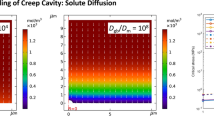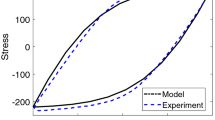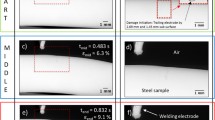Abstract
The possibility of creep cavity formation at subboundaries in austenitic stainless steels is analysed. It is demonstrated that such nucleation is thermodynamically feasible. A minimum stress must be exceeded in order to create cavities. The nucleation is assumed to take place where subboundaries on one side of a sliding grain boundary meet subgrain corners on the other side (double ledge models). Alternative cavitation positions can be found where particles meet subboundaries. The nucleation model can quantitatively predict the observed nucleation rate. The model gives a nucleation rate that is proportional to the creep rate in agreement with many experiments.









Similar content being viewed by others
References
Lim LC (1987) Cavity nucleation at high temperatures involving pile-ups of grain boundary dislocations. Acta Metall 35(7):1663–1673. doi:10.1016/0001-6160(87)90114-3
Presland AEB, Hutchinson RI (1963–64) The effect of substructure on the nucleation of grain-boundary cavities in magnesium. J Inst Metals 92:264–269
Sandström R, Wu R (2013) Influence of phosphorus on the creep ductility of copper. J Nucl Mater 441(1–3):364–371. doi:10.1016/j.jnucmat.2013.06.020
He J, Sandström R (2016) Modelling grain boundary sliding during creep of austenitic stainless steels. J Mater Sci 51(6):2926–2934. doi:10.1007/s10853-015-9601-0
Cui Y, Sauzay M, Caes C, Bonnaillie P, Arnal B (2014) Modeling and experimental study of long term creep damage in austenitic stainless steels. Proc Mater Sci 3:122–128. doi:10.1016/j.mspro.2014.06.023
Laha K, Kyono J, Shinya N (2012) Copper, boron, and cerium additions in type 347 austenitic steel to improve creep rupture strength. Metall Mater Trans A 43(4):1187–1197
Shin JK, Nam SW, Lee SC (2005) A study of nitrogen effect on the characteristics of creep-rupture in 18Cr-9Ni austenitic steels. Key Eng Mater 297-300:409–414
Laha K, Kyono J, Sasaki T, Kishimoto S, Shinya N (2005) Improved creep strength and creep ductility of type 347 austenitic stainless steel through the self-healing effect of boron for creep cavitation. Metall Mater Trans A 36:399–409
Hong JH, Nam SW, Choi SP (1986) The influences of sulphur and phosphorus additions on the creep cavitation characteristics in type 304 stainless steels. J Mater Sci 21(11):3966–3976. doi:10.1007/PL00020267
Harris JE (1965) An analysis of creep ductility of magnox Al80 and its implications. J Nucl Mater 15(3):201–207
Harris JE (1965) Nucleation of creep cavities in magnesium. Trans Metall Soc AIME 233:1509
Crossman FW, Ashby MF (1975) The non-uniform flow of polycrystals by grain-boundary sliding accommodated by power-law creep. Acta Metall 23(4):425–440. doi:10.1016/0001-6160(75)90082-6
Ghahremani F (1980) Effect of grain boundary sliding on steady creep of polycrystals. Int J Solids Struct 16(9):847–862. doi:10.1016/0020-7683(80)90053-0
Zhang J, Luévano AJ, Przystupa MA (1994) Microstructural models for quantitative analysis of grains and second-phase particles. Mater Charact 33(2):175–185. doi:10.1016/1044-5803(94)90081-7
Needham NG, Wheatley JE, Greenwood GW (1975) The creep fracture of copper and magnesium. Acta Metall 23(1):23–27. doi:10.1016/0001-6160(75)90065-6
Needham NG, Gladman T (1980) Nucleation and growth of creep cavities in a type 347 steel. Metal Sci 14(2):64–72
Page RA, Lankford J (1983) Characterization of creep cavitation in sintered alumina by small-angle neutron scattering. J Am Ceram Soc 66(8):c146–c148. doi:10.1111/j.1151-2916.1983.tb10116.x/pdf
Sandstrom R, Wu R, Hagstrom J (2016) Grain boundary sliding in copper and its relation to cavity formation during creep. Mat Sci Eng 651:259–268. doi:10.1016/j.msea.2015.10.100
Laha K, Kyono J, Shinya N (2010) Suppression of creep cavitation in precipitation-hardened austenitic stainless steel to enhance creep rupture strength. Trans Indian Inst Met 63(2–3):437–441
Chen I-W, Argon AS (1981) Creep cavitation in 304 stainless steel. Acta Metall 29:1321–1333
ECCC (2005) European Creep Collaborative Committee DATA SHEETS 2005—HR3C.120
Čermák J (1991) Grain boundary self-diffusion of 51Cr and 59Fe in austenitic NiFeCr alloys. Mater Sci Eng A 148(2):279–287
Clark CL (1953) High temperature alloys (Hochwarmfeste Legierungen). Pitman Publishing Corporation, New York
Arai M, Ogata T, Nitta A (1996) Continuous observation of cavity growth and coalescence by creep-fatigue tests in SEM. Jpn Soc Mech Eng 39(3):382–388
NIMS creep data sheet for austenitic stainless steels. http://smds.nims.go.jp/creep/index_en.html
Pitkänen H, Alatalo M, Puisto A, Ropo M, Kokko K, Vitos L (2013) Ab initio study of the surface properties of austenitic stainless steel alloys. Surf Sci 609:190–194. doi:10.1016/j.susc.2012.12.007
02 AHV (1991) Properties and selection: nonferrous alloys and special-purpose materials. ASM
Wang R, Wang S, Wu X (2011) Edge dislocation core structures in FCC metals determined from ab initio calculations combined with the improved Peierls-Nabarro equation. Phys Scripta. doi:10.1088/0031-8949/83/04/045604
Hirth JP, Lothe J (1982) Theory of dislocations, 2nd edn. Wiley, New York
Rohrer GS, Holm EA, Rollett AD, Foiles SM, Li J, Olmsted DL (2010) Comparing calculated and measured grain boundary energies in nickel. Acta Mater 58(15):5063–5069. doi:10.1016/j.actamat.2010.05.042
Schaefer HE, Maier K, Weller M, Herlach D, Seeger A, Diehl J (1977) Vacancy formation in iron investigated by positron annihilation in thermal equilibrium. Scr Metall 11(9):803–809. doi:10.1016/0036-9748(77)90079-5
Challeger KD, Moteff J (1973) Quantitative characterization of the substructure of AISI 316 stainless steel resulting from creep. Metall Trans 4:749–755
Cuddy LJ (1970) Internal stresses and structures developed during creep. Metall Trans 1:395–401
Michel DJ, Moteff J, Lovell AJ (1973) Substructure of type 316 stainless steel deformed in slow tension at temperatures between 21 and 816 °C. Acta Metall 21:1269–1277
Ryan ND, McQueen HJ (1986) Dynamic recovery and strain hardening in the hot deformation of type 317 stainless steel. Mater Sci Eng 81:259–272
Arzate OR, Martinez L (1988) Creep cavitation in type 321 stainless steel. Mater Sci Eng A 101:1–6
Beere W, Speight MV (1978) Creep cavitation by vacancy diffusion in plastically deforming solid. Met Sci 21(4):172–176
Rice JR (1981) Constraints on the diffusive cavitation of isolated grain boundary facets in creeping polycrystals. Acta Metall 29:675–681
He J, Sandström R (2016) Prediction of creep rupture strength for austenitic stainless steels. To be published
Smith E, Barnby JT (1967) Crack nucleation in crystalline solids. Metal Sci J 1:56–64
Raj R, Ashby MF (1975) Intergranular fracture at elevated temperature. Acta Metall 23(6):653–666. doi:10.1016/0001-6160(75)90047-4
Raj R (1978) Nucleation of cavities at second phase particles in grain boundaries. Acta Metall 26(6):995–1006. doi:10.1016/0001-6160(78)90050-0
Yoo MH, Trinkaus H (1983) Crack and cavity nucleation at interfaces during creep. Metall Trans A 14(3):547–561. doi:10.1007/BF02643772
Needleman A, Rice JR (1980) Plastic creep flow effects in the diffusive cavitation of grain boudaries. Acta Metall 28(10):1315–1332
Chokshit AH, Mukherjee AK (1989) An analysis of cavity nucleation in superplasticity. Acta Metall 37(11):3007–3017
Jiang XG, Earthman JC, Mohamed FA (1994) Cavitation and cavity-induced fracture during superplastic deformation. J Mater Sci 29(21):5499–5514. doi:10.1007/BF00349941
Acknowledgement
Financial support through by the European Union (directorate-general for energy), within the project MACPLUS (ENER/FP7EN/249809/MACPLUS) in the framework of the Clean Coal Technologies is gratefully acknowledged. The authors would like to thank the China Scholarship Council (CSC) for funding a stipend (File No. 201207090009) for Junjing He.
Author information
Authors and Affiliations
Corresponding author
Ethics declarations
Conflict of interest
The authors declare that they have no conflict of interest.
Rights and permissions
About this article
Cite this article
He, J., Sandström, R. Formation of creep cavities in austenitic stainless steels. J Mater Sci 51, 6674–6685 (2016). https://doi.org/10.1007/s10853-016-9954-z
Received:
Accepted:
Published:
Issue Date:
DOI: https://doi.org/10.1007/s10853-016-9954-z




